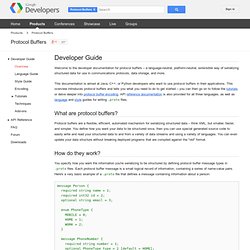

Richard G. Baldwin's all articles - Developer.com: Your Home for Java and Open Source Development Knowledge. Adding Animated Movement to Your Java Application Other Java Article Published February 24, 2009 Learn how to add animated movement into your program where multiple objects chase a lead object as it moves randomly in a given environment.

A Slider-Controlled Softening Program for Digital Photos Other Java Article Published February 10, 2009 Learn how to write a Java program to apply a blurring or softening filter to your digital photos. 3D Displays, Color Distance, and Edge Detection Other Java Article Published January 27, 2009 Learn about color distance, projecting 3D coordinates onto a 2D display plane, and edge detection. A Pixel Editor Program in Java: Multimedia Programming with Java.
Algorithms. Java Performance Tuning Training Video. Frameworks. Games. Annotations. Ajax. Tutorials. Security. Groovy. Threading. JFace. Developer Guide - Protocol Buffers - Google Code. Welcome to the developer documentation for protocol buffers – a language-neutral, platform-neutral, extensible way of serializing structured data for use in communications protocols, data storage, and more.

This documentation is aimed at Java, C++, or Python developers who want to use protocol buffers in their applications. This overview introduces protocol buffers and tells you what you need to do to get started – you can then go on to follow the tutorials or delve deeper into protocol buffer encoding. API reference documentation is also provided for all three languages, as well as language and style guides for writing .proto files. What are protocol buffers? Protocol buffers are a flexible, efficient, automated mechanism for serializing structured data – think XML, but smaller, faster, and simpler.
How do they work? You specify how you want the information you're serializing to be structured by defining protocol buffer message types in .proto files. Why not just use XML? A bit of history. Caching, Parallelism and Scalability. When your boss asks you to rewrite your application to be more performant and handle greater throughput, what do you do?

Once upon a time, when Moore’s Law held steady, all you had to do was to go drink a soy latte, play some Doom, twiddle your thumbs for a few months on the pretext of rewriting your application, and then redeploy it. Unchanged. Just onto more current hardware. Moore’s Law - from Intel co-founder Gordon Moore - ensured that the rate at which computers got faster was enough to provide performance gains that can automatically be realized by your application to cope with growth in demand.
The key word here is “automatically”. "Moore’s Law is dead. Since about 2005 though, Moore’s Law has stopped being relevant. Amdahl’s law is relevant because, since about 2005, hardware manufacturers have hit limits regarding how much performance they can squeeze out of CPUs. So no more playing Doom, there is work to be done. And this is where caching comes in. Optimistic locks. Build your own profiling tool.
Java Generics FAQs - Under The Hood Of The Compiler.